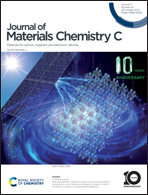Electric field and strain engineering tuning of 2D Gr/α-Ga2O3 van der Waals heterostructures†
Abstract
Functional electrical devices based on two-dimensional (2D) materials can benefit from the considerable potential of van der Waals heterostructures (vdWHs). We investigated the electrical characteristics, contact behavior, and optical performance of 2D metal-semiconductor vdWHs comprised of graphene and α-Ga2O3, in which α-Ga2O3 possesses two polarization states that are diametrically opposed to one another (α-Ga2O3↑ and α-Ga2O3↓). Utilizing first-principles calculations, Gr/α-Ga2O3↑ vdWHs have n-type Schottky contacts, while Gr/α-Ga2O3↓ vdWHs have n-type Ohmic contacts. Applying strains and electric fields efficiently regulates the band alignment between these two substances, which can reach different contact types. Moreover, our research findings suggest that vertical strains and electric fields can boost the carrier concentration in the Gr layer to about ∼1013 cm−2. Besides, the Gr/α-Ga2O3 vdWHs have much higher optical absorption than the isolated α-Ga2O3 monolayers in the visible and UV spectral regions. Consequently, the fact that Gr/α-Ga2O3 vdWHs are capable of attaining controlled contact types makes them especially well-suited for use in applications involving electrical and optoelectronic devices.



 Please wait while we load your content...
Please wait while we load your content...